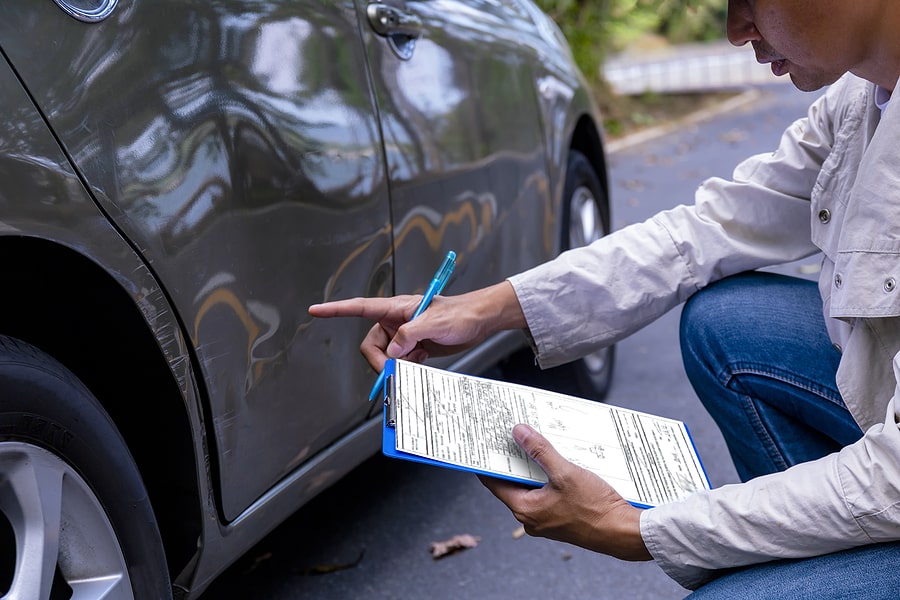When a car accident happens, the police usually respond and file a report. Police reports are necessary documents during the insurance claim process after a car accident. They provide a summary of the crash and can take a couple of weeks for the responding officer to complete.
Usually, anyone can pay a small fee to obtain a copy of the police report from the law enforcement agency that responded to the accident scene once it is complete. Drivers can often get a free copy from their insurance adjuster, as well.
Many crashes result in one or more vehicles sustaining serious damage. Therefore, some police reports include a vehicle damage rating. In this blog post, we describe what you need to know about the vehicle damage rating.
What Does a Police Report Document?
In a standard police report, the officer records basic information about the accident. This information generally includes the date and place of the vehicle accident, and the report may include details such as significant landmarks nearby. Many officers also include a description of the weather condition at the time of the crash.
A police report also includes information about each driver and any passengers involved, such as their names and addresses, driver’s license numbers, dates of birth, and phone numbers. They generally include descriptions of and details about the vehicles, as well.
Passengers are important since they can be the best witnesses of the collision, and the report will often include their statements about the crash. If third-party witnesses were at the scene when the crash occurred, the report may also contain their statements. A police report will also include descriptions of any citations the officer issued, roadway conditions, and a diagram of the crash.
Sometimes, the drivers themselves fill out a report rather than a responding officer. The police do not always respond to minor occurrences, such as a fender bender in a parking lot. If you must record information about the crash yourself, you should describe the incident in as much detail as possible.
Vehicle Damage Rating
When the officer writes down the facts about any involved vehicles, they assess the damage those vehicles sustained. They may assign a vehicle damage rating based on their findings. However, not every police report will include this rating. If it is included, three different values go into a vehicle damage rating:
- The first is the direction of force, which is the direction in which the car was struck. Usually, this is a number, which you can often compare to numbers on a clock. For example, a 6 might be directly behind the vehicle, and a 3 may mean the car was hit from the side.
- The damage description is usually a series of letters that describes either the location of damage to the vehicle or the type of collision.
- Lastly, the severity of damage depicts how much destruction a vehicle endured. Similar to the direction of force, the severity value uses a range of numbers. Generally, the scale is between one and six or seven. The worse the impact, the higher the rating.
When a police report has a vehicle damage rating, the average person should interpret it with ease.
The Four Car Damage Categories
When the insurance company looks into the accident, an inspector will evaluate the damage to each vehicle. They usually classify the vehicle damage into one of four categories. In the past, the categories were A, B, C, and D. The previous system relied on the monetary cost for grouping. The current system takes financial loss into account but focuses on safety concerns.
The four categories are:
- N: The at fault party’s insurance company wants to see the vehicle labeled as category N. This classification refers to minor damage, like a broken headlight. Usually, the car does not have a ruined body or frame. The owner can still drive the vehicle safely. However, they should not do so if necessary safety features such as the brakes or turn signals need to get fixed.
- S: In this category, a car has major damage, but can be repaired. The category might mean the vehicle has a ruined frame. A professional can likely salvage it. The owner cannot drive the car until a licensed mechanic completes extensive repairs.
- B: Category B means a person cannot ever use the vehicle again. The car is only good for extracting and selling parts. Most of the time, if your car has been categorized this way, your insurer will not allow you to remove any parts. A salvage yard will get rid of the damaged pieces.
- A: This classification means the wreck completely ruined the car. No one can remove and re-sell parts. A scrapyard it often times the destination of a vehicle labeled with this rating.
Does a Police Report Affect Your Claim?

Typically, a car accident leads to one or more insurance claims. The insurance companies conduct investigations, and one of the first documents they look at is the police report. However, their opinion may be different from the police officer’s opinion. The claims adjuster does not have to accept the information in the report. The adjuster can disagree with the severity of the damage. Even if the police report is in your favor, the other party’s insurer can still attempt to deny or minimize your claim.
If you or the other party end up taking the case to court, a police report may serve as useful evidence in court. Contact an experienced Las Vegas car accident attorney or a Reno car accident lawyer to get an idea about the particulars of your case, and use their experience to maximize your settlement in an auto accident claim.


